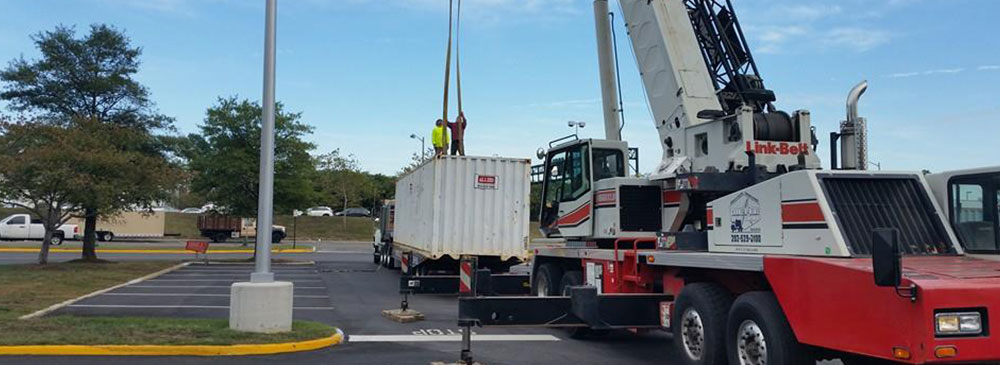
When it comes to transporting heavy equipment, you need to be ultra-cautious to ensure that the equipment reaches the destination safely. To do this you need to observe a set of best practices.
Best practices before loading the equipment
You need to ensure that you don’t exceed the transport vehicle’s gross weight rating and/or gross combination weight.
If the equipment is too large, determine whether you need permits for oversized or overwidth movements. These loads may additionally necessitate warning flags, lights, and oversized or wide load banners.
Are there any loading requirements for the equipment, such as the usage of locking pins, brakes, specific transmission gear, outriggers, or deck wideners? You should find them.
As a rule of thumb determine where you will place the equipment on the transport vehicle to ensure proper weight distribution and securement.
Heavy equipment movers also recommend that you check the equipment’s securement points for wear and damage. If they are damaged, don’t use them.
If there will be friction between the equipment and the transport vehicle (for example, metal crawler tracks on a metal deck), consider if you need friction devices.
If the item you need to move has rubber tires, check the pressure. Low pressure may cause the tiedowns to loosen.
Remember to remove any excess aggregate, dirt, debris, or other materials that could fall or reduce friction during transport.
Best practices when loading the equipment
You shouldn’t operate or load equipment that you are unfamiliar with or cannot operate safely. When possible, put the equipment against a vehicle structure to help prevent forward movement, unless weight distribution or securement considerations prevent this.
To avoid damaging brake or hydraulic lines or cylinders, attach securement devices with caution.
Remember to use edge protection to safeguard the tiedowns and equipment.
Whenever possible, use the equipment manufacturer’s designated connection points and adhere to the manufacturer’s securement guidelines.
Attach each tiedown as close to the vehicle’s front and rear as practicable. You can also attach it to mounting points on the vehicle specifically built for that purpose.
Do not use any attachment point with doubtful strength or compatibility.
Chain is the main tiedown method for large equipment and machinery. Ensure that no links are strained or have nicks.
Use direct tiedowns whenever possible, but keep in mind that you require more tiedowns than indirect tiedowns.
To keep wheeled vehicles from moving, place chocks, cradles, wedges, or other measures against the wheels. These devices require security.
Best practices after loading the equipment
You need to lower all ancillary equipment and movable parts, such as hydraulic shovels, booms, plows, crane arms, and so on, and secure them to the transport vehicle with tiedowns.
For the accessories with locking pins or similar devices that prevent movement in any direction, you do not need to secure them with additional security measures.
Hydraulics alone are insufficient to secure auxiliary equipment so if possible use additional units.
If the equipment being transported has an articulation point, pivot, or hinge in its design, secure or constrain the vehicle or equipment to prevent articulation during transit.
You need to secure accessories and other items not attached to the equipment to the transport vehicle in accordance with the normal cargo securement rules.
When doing this, confirm the vehicle’s true height and breadth.
Perform all needed en-route security assessments.
Have minimum tiedown requirements
If the loaded vehicle has crawler tracks or wheels, you need at least four tiedowns to prevent the equipment from moving side-to-side, forward, rearward, and vertically.
You should note that an indirect tiedown routed through an anchor point and attached to both sides of the trailer is considered a single tiedown.
You can use a chain as two tiedowns provided it is appropriately linked to two anchor points with two binders and has slack in the middle, ensuring that a break in the chain does not affect each tiedown.
For peace of mind, the total working load limits of the tiedowns must be at least 50% of the cargo’s weight. If the cargo weight is unknown, you may need more tiedowns.
You can attach the tie-downs near the front and back of equipment, or at the mounting locations of the equipment intended for that purpose.
Ensure that you play by the load securement laws
During Roadcheck, inspectors will largely do the Level I inspection, which is a thorough 37-step examination of the vehicle and the driver’s credentials.
To ensure that you are on the right size, ensure that spare tires, loads, goods, tools, and dunnage are securely fastened and do not fall, blow, spill, or leak off the vehicle, or roll or shift while in transportation.
Also, ensure that there are enough tiedowns for the weight and length of the equipment being transported.
Check for faulty tiedowns, which may be loose, torn, broken, crooked, or knotted. If you have a problem, fix it immediately.
Inspect the anchor points and buildings for damage. You also need to confirm that you observe commodity-specific cargo security standards at all times.
Parting shot
These are some of the things you should do to ensure that your load is safe at all times during transportation.
You can do the transportation by yourself but for the best outcome, let an experienced heavy machinery moving company handle the work.
The beauty of hiring a company is that you are sure that they will deliver your equipment safely and without any problems. You are also sure that they will pay attention to all the laws and your equipment won’t be held on the road due to lack of compliance.
When you are hiring a heavy machinery moving VA company, don’t hire the first one that you come across. Instead, take your time to find a reputable one who will have the necessary equipment and experience. Don’t take risks on a piece of expensive equipment.